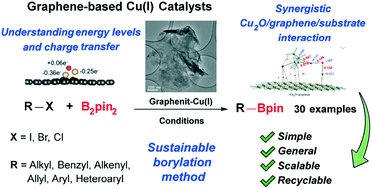Evaluation of the role of graphene-based Cu(i) catalysts in borylation reactions†
Abstract
Carbon-supported catalysts have been considered as macromolecular ligands which modulate the activity of the metallic catalytic center. Understanding the properties and the factors that control the interactions between the metal and support allows a fine tuning of the catalyzed processes. Although huge effort has been devoted to comprehending binding energies and charge transfer for single atom noble metals, the interaction of graphenic surfaces with cheap and versatile Cu(I) salts has been scarcely studied. A methodical experimental and theoretical analysis of different carbon-based Cu(I) materials in the context of the development of an efficient, general, scalable, and sustainable borylation reaction of aliphatic and aromatic halides has been performed. We have also examined the effect of microwave (MW) radiation in the preparation of these type of materials using sustainable graphite nanoplatelets (GNP) as a support. A detailed analysis of all the possible species in solution revealed that the catalysis is mainly due to an interesting synergetic Cu2O/graphene performance, which has been corroborated by an extensive theoretical study. We demonstrated through DFT calculations at a high level of theory that graphene enhances the reactivity of the metal in Cu2O against the halide derivative favoring a radical departure from the halogen. Moreover, this material is able to stabilize radical intermediates providing unexpected pathways not observed using homogeneous Cu(I) catalysed reactions. Finally, we proved that other common carbon-based supports like carbon black, graphene oxide and reduced graphene oxide provided poorer results in the borylation process.



 Please wait while we load your content...
Please wait while we load your content...